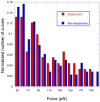Identification of Individual Target Molecules Using Antibody-Decorated DeepTipTM Atomic-Force Microscopy Probes
- PMID: 38667203
- PMCID: PMC11048431
- DOI: 10.3390/biomimetics9040192
Identification of Individual Target Molecules Using Antibody-Decorated DeepTipTM Atomic-Force Microscopy Probes
Abstract
A versatile and robust procedure is developed that allows the identification of individual target molecules using antibodies bound to a DeepTipTM functionalized atomic-force microscopy probe. The model system used for the validation of this process consists of a biotinylated anti-lactate dehydrogenase antibody immobilized on a streptavidin-decorated AFM probe. Lactate dehydrogenase (LDH) is employed as target molecule and covalently immobilized on functionalized MicroDeckTM substrates. The interaction between sensor and target molecules is explored by recording force-displacement (F-z) curves with an atomic-force microscope. F-z curves that correspond to the genuine sensor-target molecule interaction are identified based on the following three criteria: (i) number of peaks, (ii) value of the adhesion force, and (iii) presence or absence of the elastomeric trait. The application of these criteria leads to establishing seven groups, ranging from no interaction to multiple sensor-target molecule interactions, for which force-displacement curves are classified. The possibility of recording consistently single-molecule interaction events between an antibody and its specific antigen, in combination with the high proportion of successful interaction events obtained, increases remarkably the possibilities offered by affinity atomic-force microscopy for the characterization of biological and biomimetic systems from the molecular to the tissue scales.
Keywords: affinity atomic-force microscopy; antibody; antigen; functionalization; single-molecule resolution.
Conflict of interest statement
The DeepTipTM probes and MicroDeckTM substrates were kindly supplied by Bioactive Surfaces S.L., who partially funded this research.
Figures






References
-
- Binnig G., Quate C.F., Gerber C. Anonymous Scanning Tunneling Microscopy. Springer; Dordrecht, The Netherlands: 1986. Atomic Force Microscope; pp. 55–58.
-
- Eroles M., Lopez-Alonso J., Ortega A., Boudier T., Gharzeddine K., Lafont F., Franz C.M., Millet A., Valotteau C., Rico F. Coupled mechanical mapping and interference contrast microscopy reveal viscoelastic and adhesion hallmarks of monocyte differentiation into macrophages. Nanoscale. 2023;15:12255–12269. doi: 10.1039/D3NR00757J. - DOI - PubMed
-
- Martín-González N., Hernando-Pérez M., Condezo G.N., Pérez-Illana M., Šiber A., Reguera D., Ostapchuk P., Hearing P., Martín C.S., de Pablo P.J. Adenovirus major core protein condenses DNA in clusters and bundles, modulating genome release and capsid internal pressure. Nucleic Acids Res. 2019;47:9231–9242. doi: 10.1093/nar/gkz687. - DOI - PMC - PubMed
Grants and funding
LinkOut - more resources
Full Text Sources
Miscellaneous

